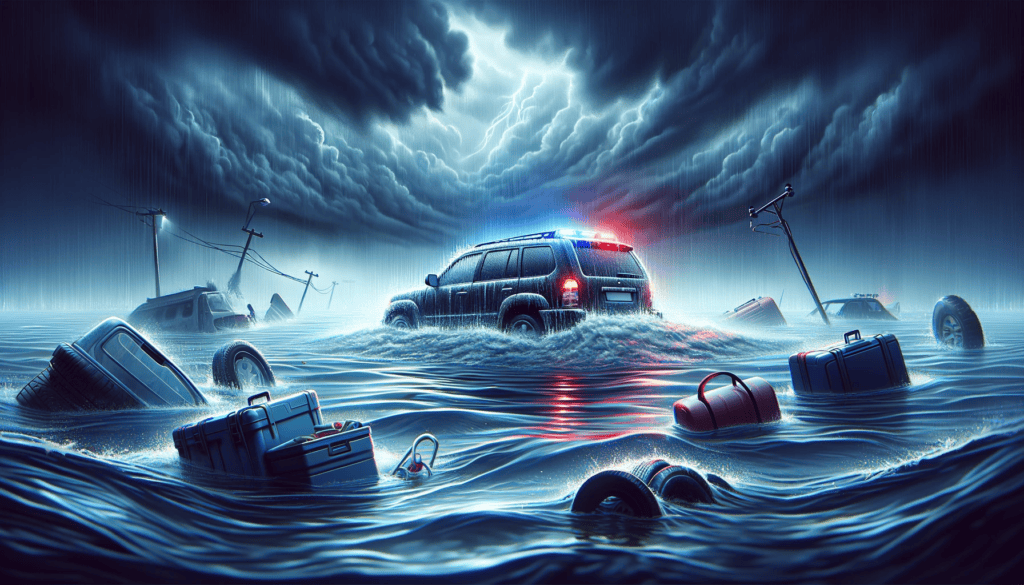Table of Contents
Every year, numerous vehicles are damaged or destroyed by floods. Flooded vehicles can pose significant risks, not just in terms of the financial burden but also in terms of safety. This comprehensive guide aims to equip vehicle owners with the necessary information to protect their vehicles from flood damage and to handle the aftermath of a vehicle being flooded.
Pre-Storm Preparation
Understanding the Risk
Before a storm hits, it’s crucial to assess the flood risk in your area. Pay attention to weather forecasts and flood warnings. If your region is prone to flooding, take preemptive actions to safeguard your vehicle.
Preventive Measures
- Elevate Your Vehicle: If possible, park your vehicle on higher ground. Floodwaters accumulate in low-lying areas, so parking at the top of a hill or in a higher level of a multi-story parking garage can be effective.
- Seal and Secure: Ensure that all windows, doors, and the sunroof are tightly closed to prevent water ingress. Also, consider using protective covers that are designed for flood prevention.
- Battery Disconnection: In situations where you might have to leave your vehicle in an area that could get flooded, disconnecting the battery can help protect the electrical and computerized components of your vehicle.
- Avoid Puddles: When driving during or after a storm, avoid puddles as they can be deeper than they appear and can damage your vehicle’s undercarriage.
Immediate Actions During the Storm

Safety First
Personal safety should always be your priority. Never attempt to drive through floodwaters. Just a foot of water can float many vehicles, and two feet of rushing water can carry away most vehicles, including SUVs and pickups.
Emergency Measures
If you find yourself in a vehicle during flooding, turn off the engine and move to higher ground if it’s safe to do so. If your car is suddenly surrounded by water, the best course of action is to abandon it and seek safety.
Post-Storm Actions
Assessing the Damage
After the storm, evaluate your vehicle’s condition. Check the depth of the floodwater in relation to your car. Do not start a flooded car as this could cause more damage, especially if there’s water in the engine.
Insurance Process
Contact your insurance company immediately if your vehicle sustains flood damage car. Flood damage to vehicles is generally covered under comprehensive coverage, but not under liability insurance. Be prepared to provide details of the damage for your claim
Repair and Recovery
Once safe to do so, begin the recovery process for your vehicle:
- Dry Out the Vehicle: Act quickly to dry out your vehicle. This involves removing any standing water, using cloth towels to absorb water in the seats and carpets, and employing fans or dehumidifiers to speed up the drying process.
- Mechanical Inspection: Have a qualified mechanic inspect your vehicle. They should check for water in the engine, oil, and transmission fluid, and inspect for any corroded or damaged components.
- Electrical System Check: The mechanic should also examine the electrical components, as water can cause significant damage to the vehicle’s electrical system.
Insurance and Legal Aspects
Your insurance company will determine whether your vehicle is a total loss or if it can be repaired. This decision is based on the extent of the damage and the cost of repairs compared to the vehicle’s value. Be sure to understand your policy’s terms and the process involved in either case.
Long-Term Considerations
Repair or Replace
Deciding whether to repair or replace a flooded vehicle depends on several factors:
- Extent of Damage: Significant water damage, particularly to the engine or electrical system, may warrant replacing the vehicle and may sometimes not be worth to fix anymore.
- Insurance Assessment: Your insurance provider’s assessment plays a crucial role in this decision.
- Personal Safety: Consider the long-term safety and reliability of the vehicle post-repair.
Future Preparedness
To mitigate future risks, consider the following:
- Parking and Storage: Choose parking locations wisely, especially in flood-prone areas.
- Insurance Review: Ensure your vehicle insurance includes comprehensive coverage for flood damage.
Conclusion
Managing a flooded vehicle involves immediate actions and thoughtful long-term strategies. During storms, prioritize your safety by avoiding flooded roads. After the threat subsides, assess your vehicle’s damage quickly and consult with insurance and repair experts to determine the best course of action.
Stay informed about local weather conditions to anticipate potential floods and prepare accordingly. Taking preventive measures, such as using protective covers or parking in elevated areas, can significantly reduce future risks. Being proactive and prepared helps you handle the aftermath of a flood efficiently, ensuring your safety and minimizing financial impacts.


